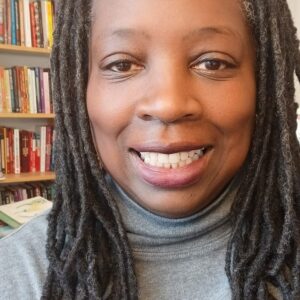Holy Cross, September 14, 2024
August 18, 2024 | by Gabrie'l Atichson
| Reading 1 | Reading 2 | Reading 3 | Reading 4 | Reading 1 Alt | Reading 2 Alt |
|---|---|---|---|---|---|
| John 3;13-17 |
Lifted Up
Black Liberation Theology is a field of Religion that emerged from African American religious traditions and various movements for racial equality. Starting as early as the 19th century, black theologians have taken up the charge of making meaning out of lynching, racist violence and anti-black discrimination.
In Dancing With God1, Karen Baker-Fletcher establishes herself as part of this intellectual tradition. She writes about the 1998 hate crime against an African American man named James Byrd in Jasper, Texas. Karen Baker-Fletcher explains that theodicy, or the belief in God’s goodness despite the presence of evil in the world, is a central facet of the African American religious tradition. And, she argues that the cross has stood as a powerful symbol for black Christians.
During the nadir, a time during the Jim Crow Era when lynching became rampant especially in the southern states, African Americans began to associate the crucifixion of Jesus to the lynching of black bodies. For Baker-Fletcher the symbolism of the cross has two aspects for black Christians. The first is a belief that God is aligned with those who suffer and die in this humiliating and painful way. The other is that Jesus’s resurrection means that God has the victory over death. Further, the cross symbolized God’s victory over all evil, including racism and discrimination.
In Dancing with God, Baker-Fletcher reinforces our passage from 1 Corinthians, “The message of the cross is foolishness to those who are perishing, but to those who are being saved it is the power of God.” (1Cor 18 NIV)
Holy Cross Day is a time for us to reflect on the symbol of the cross, and Jesus’s sacrifice made for us all. John 3:13-17 explains that the Son of Man must be lifted up just as Moses lifted up the snake in the wilderness. The story of the bronze snake is found in Numbers 21.
In Numbers, the people freed from bondage in Egypt begin to complain about the harsh living conditions in the wilderness. When they begin to speak against Moses and against God, God becomes very angry. God sends venomous snakes among the people and many die. When the people turn to Moses for help, he intercedes through prayer. God tells Moses to make a bronze snake. If someone is bitten, they can look upon the snake and live.
The Gospel reading in John explains that Jesus must also be lifted up so that we can be saved. I am considering the lifting up of Jesus in two different ways. First, Jesus is lifted up and nailed to a cross. That Jesus must be lifted up means that his body had to be broken in this way as the ultimate sacrifice for humanity. Jesus’s experience is lifted up, because it stands alone in human history. Another reading could refer to Jesus being lifted up through his resurrection and ascension into Heaven. Through this unique and divine set of circumstances, Jesus has become the one we can look upon and live.
The cross is a powerful symbol of suffering and of redemption. A savior who can feel pain and betrayal can relate to us when we feel pain. A theology focusing too much on the pain and suffering of crucifixion or one that is solely focused on the joy of Easter morning both miss the meaning of the cross. Like Baker-Fletcher, we can consider the cross as the holistic and integrated experience of Jesus and his ministry. In John we hear the power of the cross representing a savior that had to be lifted up in order for him to save us.
1Baker-Fletcher, Karen. (2006) Dancing With God: The Trinity from a Womanist Perspective. Des Peres, MO: Chalice Press.
 Gabrie’l J. Atchison earned an M.A. in Religion from Yale Divinity School, and a Ph.D. in Women’s Studies from Clark University. She is an adjunct professor of Gender Studies, a blogger, and an author. Dr. Atchison is the editor of Environment and Religion in Feminist-Womanist, Queer, and Indigenous Perspectives a series by Lexington Books. She is author of Are You The Unchurched?: How to Develop a Relationship with God Inside or Outside of Church and a co-author of More to this Confession: Relational Prison Theology with Chris Barbera. She is a contributor to Preaching the Uncontrolling Love of God, Edited by Jeff Wells, Thomas Jay Oord, et. al. and The Creation Care Bible Challenge, Edited by Marek P. Zabriskie. She lives in Buffalo, New York with her dog, Jack.
Gabrie’l J. Atchison earned an M.A. in Religion from Yale Divinity School, and a Ph.D. in Women’s Studies from Clark University. She is an adjunct professor of Gender Studies, a blogger, and an author. Dr. Atchison is the editor of Environment and Religion in Feminist-Womanist, Queer, and Indigenous Perspectives a series by Lexington Books. She is author of Are You The Unchurched?: How to Develop a Relationship with God Inside or Outside of Church and a co-author of More to this Confession: Relational Prison Theology with Chris Barbera. She is a contributor to Preaching the Uncontrolling Love of God, Edited by Jeff Wells, Thomas Jay Oord, et. al. and The Creation Care Bible Challenge, Edited by Marek P. Zabriskie. She lives in Buffalo, New York with her dog, Jack.
